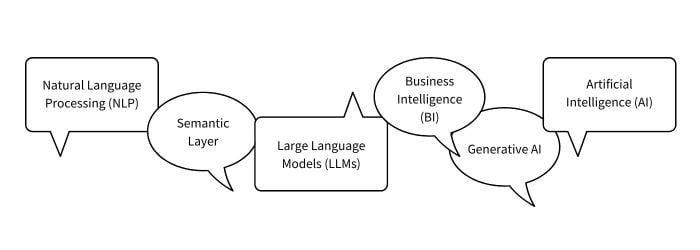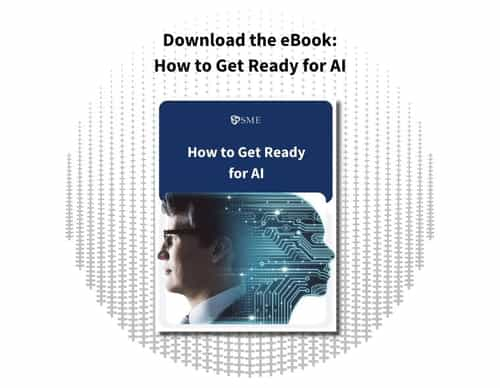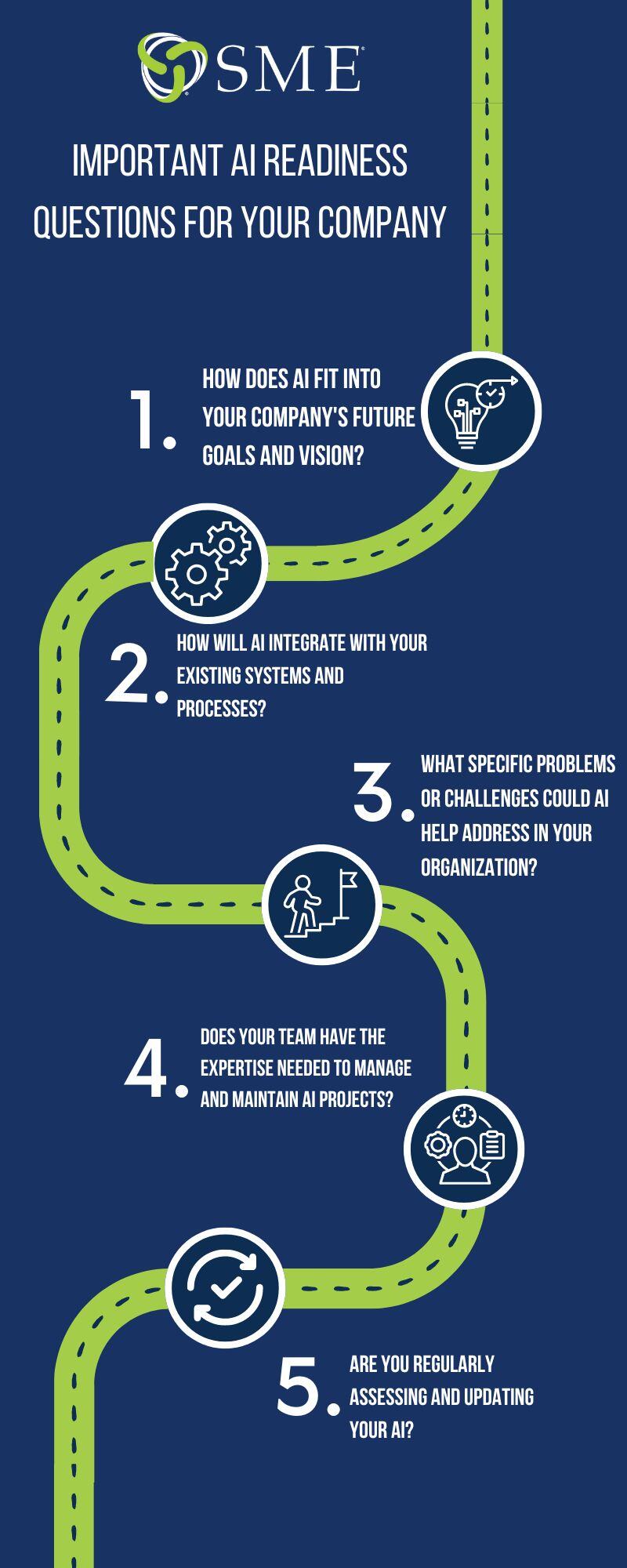AI. It's an acronym that evokes a mix of anticipation and enthusiasm among different individuals. However, for many, it can be a complex combination of technical terms and jargon.
This blog post aims to demystify a few fundamental terms: Natural Language Processing (NLP), Semantic Layer, Large Language Models (LLMs), and Generative AI, and provide some examples of how our customers are leveraging tools that bring artificial intelligence (AI) into their Business Intelligence (BI) program.
Gaining an understanding of these key terms and being aware of the available options is an important step in AI Readiness.

Let's talk NLP
Imagine having a search bar that understands plain English, not just complex code. That's the magic of Natural Language Processing (NLP). Imagine sitting at your desk, staring at a vast sea of data, unsure of where to begin. With NLP, you can simply type a question into a search bar, just like you would ask a colleague for help. You don't need to worry about complex code or SQL queries. NLP understands plain English and translates your questions into powerful commands that retrieve the relevant information you seek.
The power of NLP lies in its ability to bridge the gap between humans and machines. Instead of spending hours wrangling with code or struggling to formulate the right query, NLP enables you to effortlessly explore and analyze your data.
Imagine the possibilities. You can ask questions like, "What were our sales figures last quarter?" or "Show me the top-performing products by region." Well-implemented and trained natural language processing algorithms understand the context and meaning behind your queries, allowing you to receive accurate and relevant answers in real-time.
With the right NLP tools and end-user training, you can communicate with your data in a way that feels natural and intuitive. NLP empowers you to take control of your data analysis, making it accessible to anyone, regardless of their technical background.
And then there's the Semantic Layer
Picture a hidden layer of intelligence that sits between your data and your applications. This layer understands the meaning of your data, regardless of its format or location. It's like a translator, but for data, making it easier for different tools and applications to communicate and work together seamlessly.
Imagine a scenario where you have data stored in various databases, spreadsheets, and cloud platforms. Each source may use different terminology and formats, making it difficult to integrate and analyze the data effectively. However, with the Semantic Layer, this data can be standardized.
For example, let's say you have a sales report in one system and a customer database in another. Without the Semantic Layer, it would be challenging to connect the two and gain meaningful insights. However, with the Semantic Layer, AI links the sales data to the customer information, allowing you to analyze the impact of specific customers on sales performance.
Furthermore, the Semantic Layer also ensures data consistency and accuracy. It helps identify and reconcile discrepancies, ensuring that the data being shared and analyzed is reliable and trustworthy. This layer acts as a guardian, ensuring that the information flowing between different applications is accurate and consistent.
The Semantic Layer is the intelligent intermediary that breaks down the barriers of data silos and enables a holistic view of your data landscape.
Now, here's the cool part
You don't have to possess an extensive knowledge of data science or be an AI expert to take advantage of these technologies. SME Solutions Group works with various technologies that have integrated AI into their products. Whether you're a business professional, a data analyst, or even a curious individual, these tools are designed to make AI accessible and user-friendly for everyone.
Imagine being able to analyze complex data sets and uncover valuable insights with just a few simple questions. These tools empower you to do just that, allowing you to tap into the potential of AI-driven analytics without the steep learning curve. Instead of spending hours learning complex coding languages or relying on data scientists, you can now take control of your data analysis and make informed decisions with ease.
So, whether you're a business owner looking to optimize your operations, a data analyst seeking to uncover hidden patterns, or a curious individual interested in exploring the possibilities of AI, these tools are here to empower you. You no longer have to feel intimidated by the complexities of AI or worry about lacking technical expertise. With our tech partners' innovative solutions, AI is now within reach without the huge investment in staff or the compute costs associated with implementing AI tools like LLMs.
- ThoughtSpot & Sage: Imagine creating charts and fetching data just by typing questions in a natural language search bar. That's the power of ThoughtSpot's Everywhere and Sage, powered by NLP. No more wrestling with complex queries – just ask and get the insights you need.
- Dremio & Text to SQL: Say goodbye to writing complex SQL queries! With Dremio, you can simply type your questions in plain English, and the magic of NLP converts them into SQL, fetching the data you need instantly. It's like having a built-in data analyst at your fingertips.
- Sigma & Sigma AI: Data wrangling can be a tedious task. But Sigma AI takes the pain out of it. Just input your table or workbook, and Sigma AI's AI engine automatically cleans, curates, and prepares your data for analysis. It's like having a robot assistant do all the heavy lifting for you.
- Data.world & Bots: Finding the right data can be like searching for a needle in a haystack. But Data.world's AI-powered bots make it a breeze. They can answer your questions, suggest relevant datasets, and even enrich your data with additional metadata. It's like having a personal data concierge at your service.
See? AI doesn't have to be intimidating or exclusive to data scientists if companies are taking a thoughtful approach to it and, as always, providing end-user training.
Now, for the extra nerdy touch, let's dive deeper into two more buzzwords:
Large Language Models (LLMs): This particular algorithm falls under the umbrella of artificial intelligence (AI). It leverages advanced learning techniques and extensive datasets to comprehend, condense, create, and predict new content. Data organization and governance are crucial steps that should not be ignored when it comes to connecting your data to Large Language Models (LLMs). It's easy to get caught up in the excitement and buzz of AI, but skipping these steps is not an option. If you're not fully prepared for AI, it's best to hold off and avoid wasting valuable time. Before taking the plunge, it's crucial to take the necessary steps and ensure that your data is well-organized and centralized in a single repository rather than scattered across multiple isolated systems. This precautionary measure will set you up for success as you delve into the world of AI.
Generative AI: This broad term encompasses any AI technique that can create new content, like text, images, or code. LLMs are a powerful tool within generative AI, but not the only one. Imagine AI generating realistic product descriptions or designing personalized learning experiences – that's the potential of generative AI.
Closing Thoughts
By familiarizing yourself with concepts like Natural Language Processing, Semantic Layers, Large Language Models, and Generative AI, you'll develop a deeper understanding of the available tools and how they're revolutionizing the way we engage with data and information. Before assuming that you need to fully invest in an AI program, consider how AI can enhance your BI program and explore the various tools that bring AI capabilities to your fingertips.
So, don't hold back in embracing the exciting future of data analysis and unleashing the boundless potential of AI. However, it's important to consider starting from here instead of reinventing the wheel. Get in touch with us today to explore how these tools can transform your data analysis. Alternatively, initiate internal discussions by checking out our blog, AI Readiness: Artificial Intelligence Discussion Questions.
Get In Touch With Us Today
.png?width=700&height=127&name=Blue%20Mantis%20formerly%20known%20as%20SME%20Solutions%20Group%2c%20Inc.%20(GREEN).png)

.jpg)



